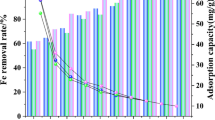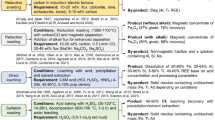Abstract
Titanium white waste acid (TWWA) was used to dissolve the representative elements from red mud (RM) to achieve the goal of “treating waste with waste.” The leaching parameters on the leaching efficiency of Na, Sc, and Al were investigated, in which the analysis of XRD and SEM–EDS on RM and leaching residue was performed. The leaching kinetics of Na, Sc, and Al was studied with unreacted shrinking core model (USCM). The results show that the dealkalization efficiency was close to 100%, and the leaching efficiency of Sc and Al was 82% and 75%, respectively. Cancrinite was dissolved from RM, and then the elements such as Na, Al, and Ca reacted with H2SO4 of TWWA. Na existed in the leaching liquor in the form of ions. Ca reacted with sulfuric acid to form anhydrite, which existed in the leaching residue. The particles of RM became smaller and dispersed with each other by acid leaching. The leaching apparent activation energy of Na, Sc, and Al was 4.947 kJ/mol, 6.361 kJ/mol, and 31.666 kJ/mol, respectively. The leaching kinetic equation of Na, Sc, and Al was 1 − (1 − a)2/3 = 0.084·exp[− 595.05/T]·t by external diffusion, 1 − 2a/3 − (1 − a)2/3 = 0.021·exp[− 765.16/T]·t by internal diffusion, and ln(1 − a)/3 + (1 − a)−2/3 – 1 = 67.12·exp[− 3808.8/T]·t by joint action, respectively.









Similar content being viewed by others
Data availability
Not applicable.
References
Abhilash, Hedrich S, Schippers A (2021) Distribution of scandium in red mud and extraction using Gluconobacter oxydans. Hydrometallurgy 202:105621
Agrawal S, Dhawan N (2021) Microwave acid baking of red mud for extraction of titanium and scandium values. Hydrometallurgy 204:105704
Bao SX, Qin L, Zhang YM, Luo YP, Huang XL (2021) A combined calcination method for activating mixed shale residue and red mud for preparation of geopolymer. Constr Build Mater 297:123789
Deng B, Li GH, Luo J, Ye Q, Jiang T (2017) Enrichment of Sc2O3 and TiO2 from bauxite ore residues. J Hazard Mater 331:71–80
Feng YL (2018) Discussion on the titration process-acid-base titration. J Hengyang Teach Coll 14:24–33
Feng QQ (2021) Uncertainty evaluation in determination of sodium oxide in mold flux by ICP-AES. Henan Metall 29:24–27
Feng X, Jiang LY, Song Y (2016) Titanium white sulfuric acid concentration by direct contact membrane distillation. Chem Eng J 285:101–111
Feng X, Wu P, Jiang LY (2018) Titanium white waste acid concentration by DCMD: wetting, crystallization, and fouling. Desalination 440:161–174
Hossain M, Karmakar D, Begum SN, Ali SY, Patra PK (2021) Recent trends in the analysis of trace elements in the field of environmental research: a review. Microchem J 165:106086
Hu B, Ouyang JT, Jiang LY (2020a) Influence of flocculant polyacrylamide on concentration of titanium white waste acid by direct contact membrane distillation. Chin J Chem Eng 28:2483–2496
Hu GH, Lyu F, Khoso SA, Zeng H, Sun W, Tang HH, Wang L (2020b) Staged leaching behavior of red mud during dealkalization with mild acid. Hydrometallurgy 196:105422
Jin JP, Liu X, Yuan S, Gao P, Li YJ, Zhang H, Meng XZ (2021) Innovative utilization of red mud through co-roasting with coal gangue for separation of iron and aluminum minerals. J Ind Eng Chem 98:298–307
Li JK, Dai J (2014) Research on treatment and utilization of “three wastes” of titanium dioxide production by sulfuric acid process. Environ Sci 33:63–66
Li SC, Zhang J, Li ZF, Liu C, Chen JP (2021a) Feasibility study on grouting material prepared from red mud and metallurgical wastewater based on synergistic theory. J Hazard Mater 407:124358
Li SW, Pan J, Zhu DQ, Guo ZQ, Shi Y, Dong T, Lu SH, Tian HY (2021b) A new route for separation and recovery of Fe, Al and Ti from red mud. Resour Conserv Recycl 168:105314
Li W, Yan XD, Niu ZP, Zhu XB (2021c) Selective recovery of vanadium from red mud by leaching with using oxalic acid and sodium sulfite. J Environ Chem Eng 9:105669
Li W, Liu Y, Zhu XB (2021d) Enhanced extraction of scandium and inhibiting of iron from acid leaching solution of red mud by D2EHPA and sodium chloride. J Cent South Univ 83:1–11
Lin LQ, Lu ZM, Zhang W (2021) Recovery of lithium and cobalt from Lithium-Ion batteries using organic aqua regia (OAR): assessment of leaching kinetics and global warming potentials. Resour Conserv Recycl 167:105416
Liu YJ, Naidu R (2014) Hidden values in bauxite residue (red mud): recovery of metals. Waste Manag 34:2662–2673
Lu MY, Wang ZY, Dai HX, Gong ZH, Wang PR (2020) Research process of recovering scandium from red mud. Multipurpose Util Miner Resour 5:9–16
Lyu F, Niu SL, Wang L, Liu RQ, Sun W, He DD (2021) Efficient removal of Pb(II) ions from aqueous solution by modified red mud. J Hazard Mater 406:124678
Pasechnik LA, Skachkov VM, Chufarov AY, Suntsov AY, Yatsenko SP (2021) High purity scandium extraction from red mud by novel simple technology. Hydrometallurgy 202:105597
Sayan E, Bayramoglu M (2001) Statistical modelling of sulphuric acid leaching of TiO2, Fe2O3 and Al2O3 from red mud. Process Saf Environ Prot 79:291–296
Smičiklas I, Smiljanić S, Perić-Grujić A, Šljivić-Ivanović M, Antonovic D (2013) The influence of citrate anion on Ni(II) removal by raw red mud from aluminum industry. Chem Eng J 214:327–335
Song YW, Wang HR (2019) Using polyvinyl alcohol to improve the deacidification performance of titanium white waste acid: pilot tests. Waste Manag 87:13–20
Song YW, Wang HE, Wang R, Zhou JC (2021) Novel approach for high-efficiency recovery of titanium dioxide, hydrochloric acid, and organic solvents from titanium white waste acid. J Clean Prod 315:128105
Sun BB, Liu J, Zhang YQ, Leungb KMY, Zeng EY (2021) Leaching of polybrominated diphenyl ethers from microplastics in fish oil: kinetics and bioaccumulation. J Hazard Mater 406:124726
Wang F, Xu J, Yin HL, Zhang YH, Pan H, Wang L (2021a) Sustainable stabilization/solidification of the Pb, Zn, and Cd contaminated soil by red mud-derived binders. Environ Pollut 284:117178
Wang SH, Jin HX, Deng Y, Xiao YD (2021b) Comprehensive utilization status of red mud in China: a critical review. J Clean Prod 289:125136
Wu WY, Chen Z, Huang Y, Li JW, Chen DY, Chen N, Su MH (2021) Red mud for the efficient adsorption of U(VI) from aqueous solution: influence of calcination on performance and mechanism. J Hazard Mater 409:124925
Xu YP, Chen CY, Lan YP, Wang LZ, Li JQ (2020) Desilication and recycling of alkali-silicate solution seeded with red mud for low-grade bauxite utilization. J Market Res 9:7418–7426
Xu ZM, Lu ZY, Zhang LS, Fan HY, Wang YF, Li JW, Lin YL, Liu H, Guo SH, Xu MY, Wang JF (2021) Red mud based passivator reduced Cd accumulation in edible amaranth by influencing root organic matter metabolism and soil aggregate distribution. Environ Pollut 275:116543
Zhang J, Li SC, Li ZF, Liu C, Gao YF, Qi YH (2020) Properties of red mud blended with magnesium phosphate cement paste: feasibility of grouting material preparation. Constr Build Mater 260:119704
Zhang WG, Zhang TG, Li TT, Lv GZ, Cao XJ (2021a) Basic research on the leaching behavior of vanadium-bearing steel slag with titanium white waste acid. J Environ Chem Eng 9:104897
Zhang YW, Qian WM, Zhou PX, Liu Y, Lei XL, Li B, Ning P (2021b) Research on red mud-limestone modified desulfurization mechanism and engineering application. Sep Purif Technol 272:118867
Zhou J, Yu Q, Huang J, Meng JJ, Chen YD, Ning SY, Wang XP, Wei YZ, Yin XB, Liang J (2020a) Recovery of scandium from white waste acid generated from the titanium sulphate process using solvent extraction with TRPO. Hydrometallurgy 195:105398
Zhou JF, Zhao JH, Yang F, Wang TL, Du F, Qin YH, Ma JY, Wu ZK, Wang CW (2020b) Leaching kinetics of potassium and aluminum from phosphorus-potassium associated ore in HCl-CaF2 system. Sep Purif Technol 253:117528
Zhou J, Ma SY, Chen YD, Ning SY, Wei YZ, Fujita T (2021) Recovery of scandium from red mud by leaching with titanium white waste acid and solvent extraction with P204. Hydrometallurgy 204:105724
Zhu XB, Li W, Guan XM (2015) An active dealkalization of red mud with roasting and water leaching. J Hazard Mater 286:85–91
Zhu XB, Li W, Tang S, Zeng MJ, Bai PY, Chen LJ (2017) Selective recovery of vanadium and scandium by ion exchange with D201 and solvent extraction using P507 from hydrochloric acid leaching solution of red mud. Chemosphere 175:365–372
Zhu XB, Niu ZP, Li W, Zhao H, Tang QJ (2020) A novel process for recovery of aluminum, iron, vanadium, scandium, titanium and silicon from red mud. J Environ Chem Eng 8:103528
Funding
The research is financially supported by the National Natural Science Foundation of China (51904097 and 51804103), the Training Program for Young Backbone Teachers in Colleges and Universities of Henan Province (2019GGJS056), the Open Foundation of State Environmental Protection Key Laboratory of Mineral Metallurgical Resources Utilization and Pollution Control (HB202106), the Scientific and Technological Project of Henan Province (202102310548), and the Science Fund for Distinguished Young Scholars of Henan Polytechnic University (J2022-3).
Author information
Authors and Affiliations
Contributions
Xiaobo Zhu, methodology, software, and writing; Chen Ma, data curation and writing—original draft preparation; Wang Li, investigation and writing—reviewing and editing.
Corresponding author
Ethics declarations
Ethics approval and consent to participate
Not applicable.
Consent for publication
Not applicable.
Competing interests
The authors declare no competing interests.
Additional information
Responsible editor: Ioannis A. Katsoyiannis
Publisher's note
Springer Nature remains neutral with regard to jurisdictional claims in published maps and institutional affiliations.
Rights and permissions
About this article
Cite this article
Zhu, X., Ma, C. & Li, W. Dissolution behavior of representative elements from red mud (RM) by leaching with titanium white waste acid (TWWA). Environ Sci Pollut Res 29, 74264–74275 (2022). https://doi.org/10.1007/s11356-022-21081-5
Received:
Accepted:
Published:
Issue Date:
DOI: https://doi.org/10.1007/s11356-022-21081-5




